Animation layers let you combine multiple animation tracks on the same object. You can use layers to store your animation experiments as you try them out, turning them on or off to your liking. To enable, add, and control layers, use commands from the Animation Layers toolbar.
Using animation layers is comparable to using both the List Controller and biped layer system, while it is more flexible and simpler for the animators to use.
When you enable animation layers for a selected object by turning them on in the Enable Anim Layers dialog, 3ds Max assigns a Layer controller to the animation tracks.
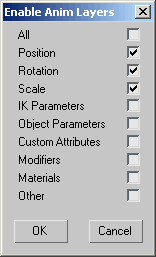
When 3ds Max adds a Layer controller, it copies the original controller into its first layer (called Base Layer), preserving any animation data it may already contain.
 The original controller before you enable animation layers |
 |
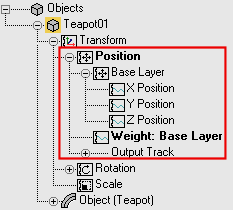 The Layer controller nests the original controller in its Base Layer. |
To revert from a Layer controller to the original controller, click Disable Anim Layer on the Animation Layers toolbar. However, if your object contains more than one animation layer, you first need to either delete or collapse them before you can disable the Base Layer.
You can assign a Layer controller either at the leaf level of a controller track (such as a material's Diffuse Color track), or at a branch level (such as a Position track).
If the selected object already has a list controller track when you enable layers, that list controller is preserved within the Base Layer of the new Layer controller.
The animation layers list works as follows (Refer to the procedure section below for common workflow examples):

The drop-down list displays all common layers (that is, with the same name); layers not common to all are unavailable.
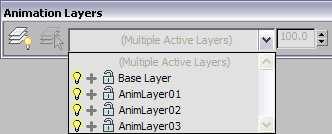
When you select multiple objects, layers not common to all are unavailable on the drop-down list.

To toggle a layer, click its light bulb icon.

To toggle a layer's inclusion in the output track, click the plus/minus sign icon.

To toggle the ability to change animation in a layer, click the lock icon for the layer.
Each animation layer has a global weight value which, when changed, impacts every controller within that active layer. Similar to the List controller, you can animate a layer's weight and toggle the visibility of the resulting keys in the Track Bar using the Track Bar Filter menu.
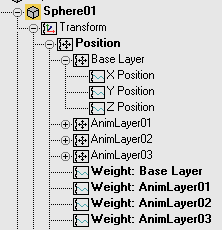
When you add a new animation layer, you can pick a name already in use by an existing layer; this links both layers' weight track, which is now instanced.
Using Merged or XRef Scenes Containing Layers
When you merge or externally reference a source scene (or object) containing layers into your master scene, the system adds the incoming layers to the master scene's layer list.
If a layer name from the merged or XRef scene matches one from the master scene, both layers become synchronized ; that is, the weight track is instanced to both of them.
Collapsing a layer merges keys if any of these conditions are met:
However, many factors can cause a collapse per frame (that is, setting a key on every frame):
Procedures: Integrating Animation Layers in a Workflow
The following sequence of procedures illustrate how you can use animation layers in your workflow to quickly create and combine different animation tracks together for the same object. You should be familiar with the basics of animation and key creation before going through the following steps.
 (Auto Key) and
(Auto Key) and  move the teapot at frames 15 and 30 to create a short animation.
move the teapot at frames 15 and 30 to create a short animation.
By default, this also creates a key at frame 1. Your start key might be at frame 0 instead; for the purposes of this example, it’s immaterial.
 Animation Layers.
Animation Layers.
 (Enable Anim Layers).
(Enable Anim Layers).
Example: To add a layer and change its controller type:
This continues from the previous procedure, in which you enabled layers for an animated object.
 (Add Anim Layer).
(Add Anim Layer).
The teapot now has two animation layers, each of which can contain a separate animation that you can control independently of the other.
 Transform
Transform  Position.
Position.
Under Position you’ll see Base Layer, Noise Layer, two Weight Tracks, and Output
Two different controllers are now driving the teapot's position.

 Play the animation to see the teapot jitter as it moves along the original animation path.
Play the animation to see the teapot jitter as it moves along the original animation path.
Example: To turn a layer on and off:
This procedure discusses turning existing layers on and off. It continues from the previous procedure.
The list currently contains both the original base layer and Noise Layer from the previous procedure.
This turns off the layer and hides the Noise controller track from the rest of the tracks.

Example: To lock and unlock a layer:
This procedure discusses locking and unlocking layers. It continues from the previous procedure.
 (Auto Key) is on, then go to frame 20 and move the teapot to set a new animation key.
(Auto Key) is on, then go to frame 20 and move the teapot to set a new animation key.

You can’t, because the layer is locked. This protects the animation on that layer from inadvertent changes.
 Base Layer track for the teapot and expand it. Highlight the X Position track (or Y Position or Z Position), then right-click
the highlighted track and from the top-left quadrant of the quad menu, choose Unlock.
Base Layer track for the teapot and expand it. Highlight the X Position track (or Y Position or Z Position), then right-click
the highlighted track and from the top-left quadrant of the quad menu, choose Unlock.
The “(Locked)” text no longer appears after the Base Layer tracks.
It is no longer locked. This shows that locking and unlocking a track in an animation layer affects all tracks controlled by that layer.
Example: To link two objects with wire parameters using the Layer Controller's output track:
This procedure refers to a simple way to use the output track to control a cube's position through wire parameters. It continues from the previous procedure.
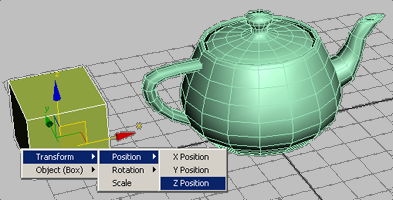
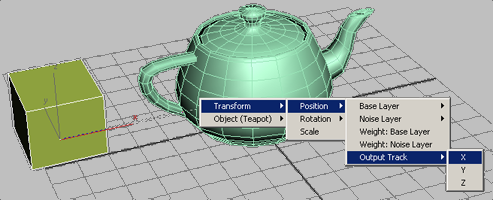
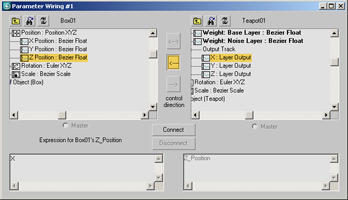
 Select the teapot and expand the layer list from the Animation Layers toolbar.
Select the teapot and expand the layer list from the Animation Layers toolbar.
This excludes the layer from the output track.

Try including and excluding both layers in the list to see the results.
Example: To copy and paste a layer and update an active layer:
This procedure continues from the previous procedure and focuses solely on the teapot.
 (Copy Anim Layer) to buffer this layer and the data it contains.
(Copy Anim Layer) to buffer this layer and the data it contains.
 (Paste New Layer). On the Rename Anim Layer dialog, enter “Changes on Z axis” as name and click OK.
(Paste New Layer). On the Rename Anim Layer dialog, enter “Changes on Z axis” as name and click OK.
 (Auto Key) is on, move the teapot on the Z axis at frames 5 and 20.
(Auto Key) is on, move the teapot on the Z axis at frames 5 and 20.
This animation update only affects the position tracks of the active layer.

This procedure continues from the previous procedure.
 (Collapse Anim Layer).
(Collapse Anim Layer).
This merges the layer onto the next available one (Base Layer), skipping Noise Layer, which is off.

 Enable Anim Layers
Enable Anim LayersAssigns a Layer controller to tracks you specify.
This opens the Enable Anim Layers dialog, which, similar to the Set Key Filters dialog, lets you turn on tracks you want to assign a Layer controller to.

The Position, Rotation, and Scale tracks are on by default. You can still animate attributes other than those enabled on this dialog, but they are not subject to control by the Layer controller.
If you enable animation layers for an object that has animation loaded in the Motion Mixer, the following dialog opens:
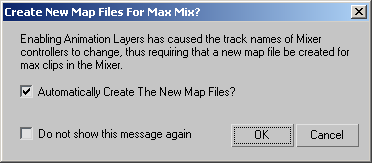
Remapping is necessary in this case because enabling Animation Layers causes the full controller names to change. For example, if a sphere's X position track before enabling Animation Layers is Sphere01\Transform\Position\X Position, then after enabling animation layers it might change to Sphere01\Transform\Position\Base Layer\X Position (the layer name is inserted into the controller name).
If you accept the default dialog option, to create the new map files automatically, 3ds Max automatically generates any necessary XMM files with the same names as the XAF files and places them in the same directory as the original map files, or if no map files exist, in the same directory as the XAF files. Thereafter, when you open this scene file the map file is loaded automatically and no additional mapping is required.
However, if you turn off Automatically Create The New Map Files? before clicking OK, no map files are generated, and the next time you open the scene file you're prompted to create map files. Without map files, the animation doesn't appear correctly.
 Select Active Layer Objects
Select Active Layer ObjectsDisplays all existing layers for the selected object. Each layer in the list contains toggle icons to turn it on or off, as well as include or exclude it from the controller's output track. See Working with Animation Layers for more details.
 Anim Layer Properties
Anim Layer PropertiesOpens the Layer Properties dialog, which lets you set global options for layers.
 Add Anim Layer
Add Anim LayerOpens the Create New Animation Layer dialog, which lets you specify settings related to the new layer. This adds a new layer to every track that has a Layer controller.
 Delete Anim Layer
Delete Anim LayerRemoves the active layer, along with the data it contains. A confirmation dialog prompts you before deletion.
 Copy Anim Layer
Copy Anim Layer Paste Active Anim Layer
Paste Active Anim Layer Collapse Anim Layer
Collapse Anim Layer Disable Anim Layer
Disable Anim Layer